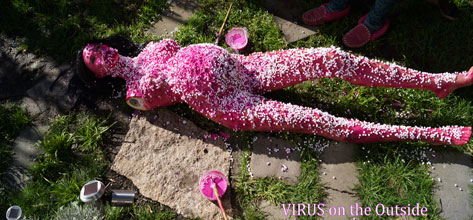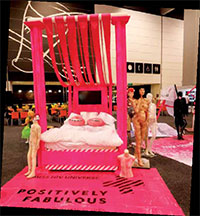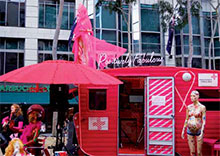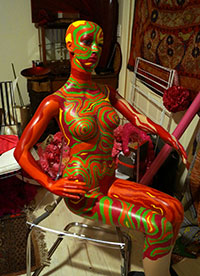Positively fabulous: the art of raising awareness and changing women’s lives
Positively fabulous: the art of raising awareness and changing women’s lives
HIV Australia | Vol. 12 No. 3 | December 2014
By Finn O’Keefe
I first met Kim Davis (or rather, her alter ego, Ma’Dam Kim, pictured), surrounded by a camera crew at ICAAP11 (the 11th International Conference on AIDS in Asia and the Pacific) in Bangkok.
Looking resplendent in a white lace head-dress covered in LED lights, and with two lights beaming out from either side of her white horn-rimmed glasses, I was transported back to the energy and creativity I recalled from my first Mardi Gras parties during the 90s.
“Absolutely fabulous!” I complimented.
“Positively Fabulous!” she corrected.
Kim Davis is an expert at playfully combining activism and art – it’s something that she’s been doing for a long time.
She is artistic director of GloballyAware, a not-for-profit organisation she founded in the 1990s, whose mission is to create major artworks and events that stimulate dialogue and achieve social change, with a focus on health education, HIV, harm reduction and human rights.
Her latest project, Positively Fabulous+, uses art to document the stories of HIV-positive women, and create safe spaces where people can engage in conversations about the realities of living with HIV.
‘Positively Fabulous is articulating how positively fabulous people living with HIV are,’ says Kim.
‘In particular, with this project it’s about women, and this is also, of course, inclusive of transgender women.’
The project combines documentary film-making [produced in collaboration with Change Media], large-scale public artworks and online platforms to create community engagement and raise awareness about how HIV affects women globally.
The idea was initially conceived in 2012, and the project was formally launched at AIDS 2014, as well as staging activities during ICAAP11 in 2013.
In just a few short years, the support and partnerships that Kim has built-up around the project is pretty staggering.
Positively Fabulous+ has partnered with organisations including the Australia Council for the Arts, the City of Melbourne, English Family Foundation, Victorian College of the Arts, Feral Arts, Australian Academy of Design, International AIDS Society, Living Positive Victoria and Straight Arrows, just to name a few.
Since its inception, Kim has staged numerous public art installations, filmed documentary content with women living with HIV across Asia and Australia, and worked with over 33 musicians and artists, and over 150 volunteers during the AIDS 2014 conference.
HIV-positive mannequins: a journey of transformation
One of the major components of Positively Fabulous+ leading up to AIDS 2014 was the HIV Adoption Centre.
The stars of this multi-platform collaborative arts project were 17 ‘HIV-positive mannequins’, representing the 17 million women globally who are living with HIV.

A mannequin part way through her process of transformation. She wears her virus on the outside of her body to fight stigma and discrimination.
The mannequins were adopted out into the community like blank canvasses, taken in by a variety of artists, organisations and community members.
The foster families were given the task of creating new identities for these HIV-positive women: ‘The brief given out was for each mannequin to be transformed into its own positively fabulous identity as a women living with HIV,’ explains Kim.
The women’s identities became a product of their adoptive family’s creativity, expressed through body art and fashion.
This journey of transformation was documented online, using photographs, text and video.
‘There was an actual adoption paper that people had to sign when they adopted the mannequins,’ she continues.
‘They would come to the adoption centre (we had one at ICAAP and another one at World AIDS Day in Federation Square), and then I connected with people and delivered the mannequins to them, or they would have a choice of what mannequin they actually wanted.
‘And the adoption papers actually articulated that each mannequin had to have their own Facebook page to log on to and engage with the broader public.’
Kim explains that the power of mixing art and humour is that it disarms people’s reluctance to engage with sensitive and taboo topics: ‘You know, it just opens up dialogue because people are curious, it is not going to offend anyone,’ she says.
‘It is about fun and frivolity, about looking at HIV and AIDS through a different lens, you know. It allows people to question their thinking, and that is the whole thing with art. What does art do? It creates a dialogue outside the boundaries of the norm.’
Watching Kim’s documentary, there is something deliciously oddball about seeing her travel round Bangkok rescuing mannequins and loading them into her car boot, or seeing a new foster parent loving brush a mannequin’s hair as they recount her story about living with HIV.
But this strategy has proved extremely effective at creating community engagement and raising awareness.
The mannequins became quite famous, garnering around 15–20,000 followers on Facebook.
Through social media, and during public art installations, powerful conversations took place which enabled people to ask questions and connect with the stories of HIV-positive women.
Each mannequin’s story reflected the diversity of issues affecting women living with HIV in different circumstances.
One mannequin chooses to fight stigma by ‘wearing her virus on the outside of her body.’ Another is living with a disability, and travels around in a bright pink wheelchair.
‘People would see the mannequins and scratch their heads, and couldn’t quite understand …
‘We had a few people from the disability sector come up who were really interested in the fact that we were having a dialogue about HIV and disability.
‘It was across the board, really, really good quality [dialogue]. I love working with all of the Positively Fabulous+ people in this arena,’ says Kim.
The culmination of the mannequins’ journey will be a fundraiser, Miss HIV Universe, which Kim is planning to stage next year at the Melbourne Town Hall, in partnership with Living Positive Victoria.
At the event, the 17 HIV-positive mannequins will be auctioned off by Sotheby’s (or ‘trafficked off ’ as Kim says, laughing), along with major HIV artworks from around the globe, with all the funds raised going directly to people living with HIV.
An initial heat of the pageant was held in the Global Village during AIDS 2014.
Creating safe spaces
Positively Fabulous+ staged eight separate events during AIDS 2014, and clusters of mannequins also featured in a range of these other installations in the Global Village.

The Babbling Boudoir was an installation piece which centred around a bright pink four poster bed.
Inserted into the back of the bed was a TV displaying the stories of HIV-positive people talking about their experiences of negotiating sex and relationships, along with a camera set up to record the stories of people passing through.
Kim explains how the installation was designed to create a space where people felt comfortable talking about the experience of negotiating sex as an HIV-positive person:
‘… people were actually on the bed telling their stories about negotiating sex when you’re living with HIV.
‘At one stage, we had ten people having a dialogue, so that was quite crazy; and then I had the Junkies’ Pool, which was an interactive installation featuring a pool table with a screen inserted in it showing people’s stories about HIV, surrounded by major artworks collaboratively created by people living with HIV from around the globe.’
Kim says she has received a lot of feedback from HIV-positive people about the value of these ‘safe SPACEs’ for sharing personal stories, connecting with other HIV-positive people and having a dialogue about HIV.
‘For many people, finding these spaces at the conference was amazing, because they were surrounded by people that were articulating HIV loudly, and it was positive people, Positively Fabulous people, that were talking – it was inspiring.
‘A young women came to talk to me following the launch of the Positively Fabulous+ Women’s Voices documentary. She’d been positive for four years and hadn’t spoken to anyone about it, and now she is a force to be reckoned with – now that makes me smile,’ says Kim.
Taking art out into the streets
Positively Fabulous+ also extended its reach beyond the confines of the conference venue with The Pink POS FAB Touring Caravan, which put down roots in Melbourne City Square for the duration of the conference.
‘It was an installation art piece with ten fabulous Australian bands engaging the audience (thanks Marisa Quigley), set up inside to record.
‘So we had people coming off the street having a dialogue with us about HIV. I had a film crew of students from the Academy of Design filming, so we were recording questions from the audience and they were coming in and talking with us about where they saw HIV fitting into their lives.’
Kim explains how, as well as initiating dialogues about living with HIV, the installation was designed to raise awareness about the presence of the conference itself.
‘I’ve been going to these conferences since the mid-nineties, and in all of that time, every conference it’s the same thing: the locals never know what’s going on and we need to expand our audience and not just talk to the converted.’

The Pink POS FAB Caravan created a profile for HIV beyond the confines of the conference.
The Pink POS FAB Caravansat side-by-side with GL RY, an interactive, performance arts project led by Dr Alyson Campbell from the Victorian College of the Arts (VCA), working with students and a team of creatives that included playwright Lachlan Philpott, lesbian bear chanteuse Ross Anderson from Belfast, and dramaturg and academic researcher, Paul Woodward.
GL RY was a pilot project set up in partnership with Living Positive Victoria to explore how performance could mobilise students and artists to learn about HIV through arts practice, as well as engaging members of the public.
Although the two projects had slightly different aims, they sat side-by side in conversation, complimenting each other perfectly.
‘It became a collaborative project between Positively Fabulous+ and us, which then turned out for me to be the really revealing thing because, of course, what you do discover very quickly is that women are very often invisible in these discourses,’ says Alyson.
‘We had heightened performance moments, like the cabaret that would happen in the evening that attracted people to stop and see what was happening,’ Alyson continues.
‘When they’ve stopped because they’re interested in what’s going on, and it’s a bit funny and absurd, then you can have productive conversations. And it works very differently from, say, if we had set ourselves up there with a table with information on it, and tried to get people to come and talk to us.
‘They might encounter new information then, but getting them to stop and hang out with us for long enough for that to happen is something that live performance can do.’
Alyson feels it was hugely beneficial to be able to refer people engaging with GL RY to also have direct conversations with HIV-positive people in the Positively Fabulous+ caravan.
‘That was hugely important for me, as the leader of a group of students to be very clear about our position and be humble and upfront about not having an embodied knowledge, or really often not much knowledge at all, initially. We were clear this was a learning project for us,’ she says.
The feelings of admiration between the two project leaders are clearly mutual.
‘Look … working with Alyson is fabulous – she is just exceptional to work with,’ says Kim.
‘We are working together, creative partners for GL RY now and I’m also the dramaturg.’
Kim and Alyson are already looking towards future opportunities, including ICAAP12 in Bangladesh and other conferences such as the Australasian HIV/AIDS Conference.
There are also tentative plans to recreate the GL RY project in other international locations.
‘There is talk of doing something in Belfast,’ Kim notes, ‘and also I’ve been talking with Laxmi (renowned transgender sex worker activist) about doing something in India.’

When I ask Kim about her hopes for future art-based projects at international AIDS conferences, she is adamant about the need for more work in this area:
‘I’ve been fighting for this since the first performance installation that I did in Geneva [at an AIDS conference] with Suzana Murni in the nineties,’ she tells me, emphatically.
‘It’s really hard when you’re in the space because there’s that political side of it where people don’t quite understand how much engagement and dialogue art creates; they don’t put it together with the scientific, and I think it’s the most important because it definitely creates a vibrant environment in quite a sterile space. So for me, is it something I want to see? God, yes.’
‘We have to keep the momentum going,’ she concludes.
‘I have read a few documents from overseas at the moment from delegates who have praised the fact of how much art there was and how great it was and also the UN are on board with it.
‘They’ve gone down that track where they’ve started to utilise the arts as well which is good, and about time. ‘I think that there needs to be more [involvement] with the IAS (International AIDS Society), there has to be more dialogue with them about how important the arts is.
‘I don’t think it should be so isolated, so it’s only the condom stage inside the conference, and all the art is basically kept in the Global Village.
‘We need to feel the voices of people living with HIV ringing out through the arts, art needs to permeate its way throughout the conference.’
Finn O’Keefe is Communications Officer at AFAO and an editor of HIV Australia.

